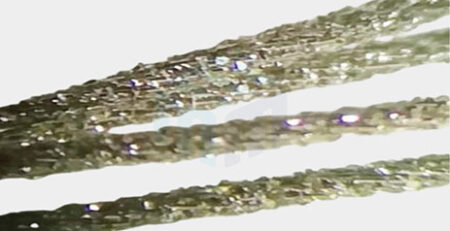Take you to understand quartz glass in one minute!
Quartz glass is a special industrial technical glass composed of a single component of silicon dioxide. It has a series of excellent properties unparalleled by ordinary glass. It is praised as the “King of Glass” by experts in the field of new materials.
It is an important basic material for national strategic emerging industries such as modern information industry, optics, photovoltaics, semiconductors, and national defense fields such as aerospace.

1. Structural characteristics of quartz glass
Pure quartz glass is composed of a single component of silicon dioxide (SiO2). The Si-O bonds are arranged in short-range order and long-range disorder. Because the bond energy of Si-O bonds is strong and relatively stable.
Therefore, it has the characteristics of high softening temperature, excellent spectral transmittance, extremely low thermal expansion coefficient and electrical conductivity, extremely high chemical stability, radiation resistance and long working life under extreme conditions.
2. Properties of Quartz Glass
(1) Optical properties
Quartz glass has a range of excellent optical properties. Compared with ordinary glass, high-purity quartz glass has good transmittance in a very wide spectrum from far ultraviolet (160nm) to far infrared (5μm), which is not available in general optical glass. Excellent spectral transmittance and optical uniformity make quartz glass widely used in semiconductor lithography and precision optical devices.
In addition, it has good radiation resistance, and radiation-resistant quartz glass has been widely used as the window material of the “Shenzhou” series of spacecraft, and the protective cover of the key components of the “Tiangong” series of space laboratories.
(2) Mechanical properties
Quartz glass is similar to ordinary glass and is a brittle and hard material. Like ordinary glass, the strength parameters are affected by many factors, including surface state, geometry, and testing methods.
The compressive strength of transparent quartz glass is generally 490~1960MPa, the tensile strength is 50~70MPa, the flexural strength is 66~108MPa, and the torsional strength is about 30MPa.

(3) Electrical properties
Quartz glass is an excellent electrical insulating material. Compared with ordinary glass, it has higher resistivity, and the resistivity of quartz glass at room temperature is as high as 1.8×1019Ω∙cm. In addition, it has a higher breakdown voltage (about 20 times that of ordinary glass) and lower dielectric loss.
The resistivity decreases slightly with increasing temperature, and the resistivity of opaque quartz glass is lower than that of transparent quartz glass.
(4) Thermal properties
Since almost all the inside of quartz glass is a strong Si-O bond, its softening temperature is very high, and the long-term working temperature can reach 1000 °C. In addition, the thermal expansion coefficient is the lowest among common industrial glasses, and its linear expansion coefficient can reach 5×10-7/℃, and the specially treated quartz glass can even reach zero expansion.
It also has very good thermal shock resistance, even if it is repeatedly subjected to extreme temperature differences in a short period of time, it will not crack. These excellent thermal properties make it irreplaceable for other glasses in high temperature and extreme working environments.
High-purity quartz glass can be used in chip manufacturing in the semiconductor industry, auxiliary materials for optical fiber manufacturing, observation windows in industrial high-temperature furnaces, high-power electric light sources, and as a thermal insulation layer on the surface of space shuttles. The extremely low coefficient of thermal expansion also enables it to be used in precision instruments, lens materials for large astronomical telescopes, etc.
(5) Chemical properties
The chemical stability is very good. Unlike other commercial glasses, it has extremely high chemical stability to water, so it can be used in water stills that require extremely high purity of water.
It has excellent acid and salt resistance, and does not react with most acids and salt solutions except for hydrofluoric acid, phosphoric acid and alkaline salt solutions. Compared with acid and salt solutions, quartz glass has poor alkali resistance and will react with alkali solutions at high temperatures.
In addition, it and most oxides, metals, non-metals and gases do not react at normal temperatures. The extremely high purity and good chemical stability allow quartz glass to be used in semiconductor manufacturing and other environments that require high production conditions.
3. Quartz glass preparation method
The preparation methods can be divided into two categories. The first type is obtained by melting natural quartz crystal or silica as raw material, which is called natural quartz glass. The first type of method can be subdivided into electrofusion method, gas smelting method, plasma fusion method, etc. according to the difference of heat source and process.
The second type is synthesized by chemical reaction of silicon-containing compounds (including silicon halide, silicon hydride and organic silicon, etc.) as raw materials, which is called synthetic quartz glass.
According to the different reaction principles, the second type of methods can be divided into: plasma chemical vapor deposition (PCVD), flame hydrolysis deposition (FHD), and sol-gel method.
4. Application of quartz glass
It is mainly used in electric light sources, semiconductors, new optical technologies, etc. New light sources: high-pressure mercury lamps, long-arc xenon lamps, tungsten iodine lamps, thallium iodide lamps, infrared lamps and germicidal lamps, etc.
Semiconductor: It is an indispensable material in the production process of semiconductor materials and devices, such as crucibles for growing germanium, silicon single crystals, boat furnace core tubes and bell jars.
In the field of new technologies: use its excellent performance of sound, light and electricity to make ultrasonic delay lines on radar, infrared tracking and direction finding, infrared photography, communications, spectrographs, and spectrophotometers, prism, lens, reflecting windows for large astronomical telescopes, high temperature operating windows, reactors, radioactive devices; rockets, missile nose cones, nozzles and radomes; radio insulation parts for artificial satellites, radiation; thermal balances, vacuum adsorption devices, precision casting, etc.
It is also used in: chemical industry, metallurgy, electrical engineering, scientific research, etc.
In chemical industry: it can be used as combustion, cooling and ventilation device for high temperature acid-resistant gas, evaporation of acid solution, cooling absorption, storage device, preparation of distilled water, hydrochloric acid, nitric acid, sulfuric acid, etc. and other physical and chemical experimental supplies.
In terms of high temperature operation: optical glass can be used, crucible can be made into fluorescent body, electric furnace core tube, gas combustion radiator,In terms of optics: quartz glass and quartz glass wool can be used as rocket nozzles, spacecraft heat shields and observation windows, etc.
In short, with the development of modern science and technology, it has been more widely used in various fields.




